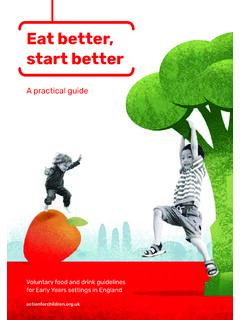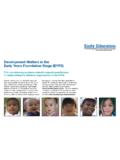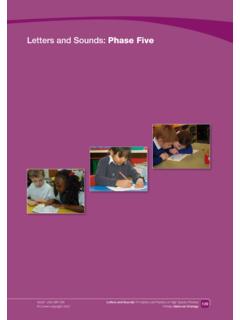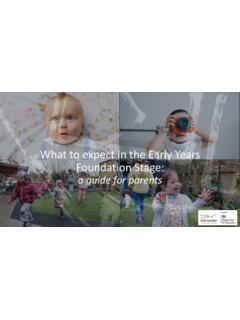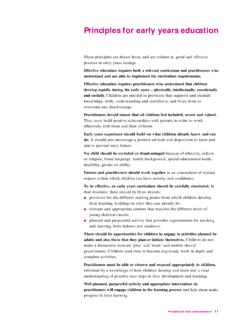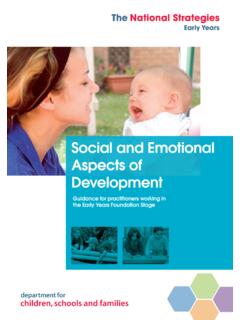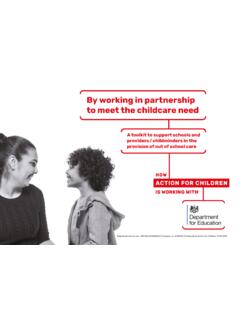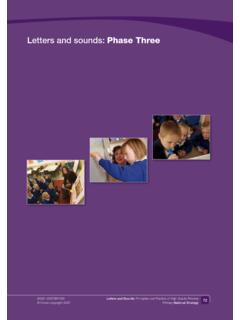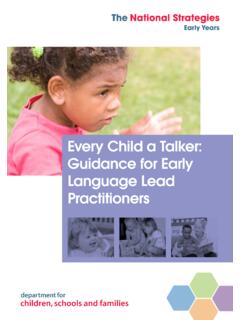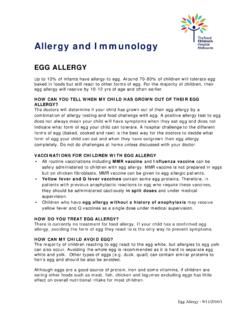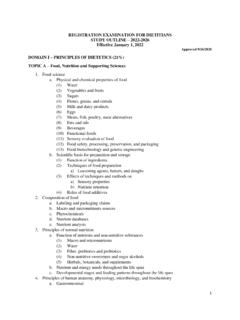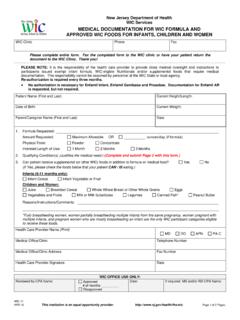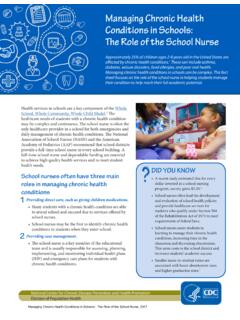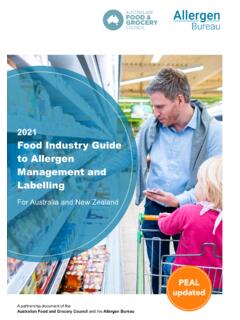Transcription of Catering for special dietary requirements - Foundation Years
1 Guide for early Years settings in Department for Education (2014). Statutory framework for the Early Years Foundation Stage. Setting the standards for learning, development and care for children from birth to five. 2 EU food Information for Consumers Regulations 1169/2011: :L:2011:304:0018:0063:EN:PDF3 Voluntary food and Drink Guidelines for Early Years Settings in England: A practice guide. Available at: IntroductionThis guide outlines the legal requirements and best practice for early Years settings when providing food and drinks for children with allergies , intolerances and other special dietary requirements . special dietsA special diet is one that cannot be selected freely from the main choices available. This could be due to an allergy, intolerance or other medical need; or because children are following a religious or cultural diet; or a vegetarian or vegan diet.
2 Are we required to cater for special diets? The Early Years Foundation Stage Statutory Framework includes the following requirements relating to special diets:1 Before a child is admitted to the setting the provider must obtain information about any special dietary requirements , preferences and food allergies that the child has, and any special health requirements ; and Providers must record and act on information from parents and carers about a child s dietary needs. In addition to this new allergen ingredients information laws which came into effect in December 2014 require early Years settings (along with other food businesses) to provide allergen ingredients information for the food and drink they This information helps to ensure that appropriate meals and snacks can be provided for children with practice:3 If a child requires a special diet, talk to their family and agree how to meet their dietary needs.
3 In some cases, you might also need to seek advice from a registered dietitian or a doctor Make sure that all staff are aware of children s individual dietary requirements , so that children s choices, beliefs and safety are respected and protected Have a policy and procedure in place to follow when you receive requests for a special diet for a child. See page 3 for guidance on this Children with special needs should be included in meal and snack times (unless otherwise indicated by their condition) with the other children in your setting Settings should work closely with dietitians and other health professionals, parents and children where medical diets are for special dietary overview of special dietsFood allergies , intolerances and other special diets for medical reasons food allergies are when the body s immune system reacts unusually to a specific food , because it mistakenly perceives it as a threat.
4 In children, common food allergies are to milk, eggs, peanuts, nuts, fish and shellfish. Symptoms can include itching in the mouth, throat or ears, a raised itchy red rash (hives), swelling of the face, around the eyes, lips, tongue and roof of the mouth and vomiting. In the most serious cases, a severe allergic reaction (anaphylaxis, which can include breathing difficulties, light headedness and feeling like you are going to faint) can be life-threatening. There is no cure for food allergies , so people with allergies need to avoid the foods to which they are allergic. It is important that children with suspected food allergies see their GP for referral to an allergy clinic for a formal diagnosis. Children with severe allergies may be given a device known as an auto-injector pen ( epi-pen) containing a dose of adrenaline to be used in emergencies, the details of which should be included as part of an allergy management plan.
5 food intolerances are different from food allergies . Symptoms tend to appear more slowly, often several hours after eating the food . Symptoms can often include diarrhoea, bloating and stomach cramps. Unlike food allergies , food intolerances are not life-threatening. Coeliac disease is not an allergy or intolerance. It is an autoimmune disease, where eating gluten triggers the immune system, damaging the lining of the gut and also affecting other parts of the body. Symptoms can include bloating, diarrhoea, nausea, wind, constipation, tiredness, headaches, mouth ulcers, sudden weight loss, hair loss and anaemia. People with coeliac disease cannot eat foods containing gluten. Gluten is a protein found in wheat, barley, rye and oats (unless specified as gluten free oats).
6 Examples of foods containing gluten include bread, pasta, flour, breakfast cereals, cakes, biscuits and pastry. Gluten can also be found in many other processed foods, such as soups, sauces, and sausages. Traces of gluten can also be found in food where gluten is not an ingredient, because of cross-contamination from gluten-containing foods. Other medical diets can include where children need to follow high energy or fat diets, or food with a modified texture to make it easier for them to chew and swallow. Settings may need to seek advice from a health professional where medical diets are required. Religious and cultural dietsMany settings cater for a diverse range of children from different backgrounds. Children from minority ethnic or religious communities may follow specific dietary customs, and may exclude or prepare food in a particular way.
7 A summary of dietary customs of different groups is available on the Trust s website, see the further advice and resources section on page four. Vegetarian and vegan diets Vegetarians do not eat meat, poultry, fish, shellfish or animal products such as lard or gelatine. There are three main types of vegetarian: Lacto-ovo-vegetarians eat both dairy products and eggs; this is the most common type of vegetarian diet. Lacto-vegetarians eat dairy products but not eggs. Vegans do not eat dairy products, eggs, or any other products derived from animals ( honey). Seek advice from a dietitian if a vegan diet is requested. Many settings include a vegetarian option as part of their menu every day, as vegetarian diets are relatively common. Vegetarian dishes can also be eaten by non-vegetarian pupils too.
8 For further information on meeting the nutritional needs of vegetarian children see the further advice and resources section on page four. for managing requests for a special diet1. Request information from the child s parent/carer, so you are aware of the child s dietary requirements before they start at the setting. If a special diet is requested for medical reasons, request written confirmation of the allergy/medical need from the child s GP, dietitian or other medical professional to make sure children are not having foods removed from their diet without a diagnosed medical need. 2. Work with the child s parent/carer (and medical professionals if required) to write and agree a clear plan of how to manage the child s special dietary requirement.
9 This should describe: details of their special dietary requirements and a clear list of the foods which can and can t be eaten how meals and snacks will be provided ( whether appropriate meals will be identified or adapted from the existing menu, or whether suitable foods will be prepared or supplied separately) precautions to take during activities involving food craft/messy play the action to take in the event of an emergency ( allergic reaction), including names, dose and administration of prescribed medication, and the staff trained to administer Ensure that all staff are fully informed (and fully understand) about individual children s dietary requirements , and how these are being met, so they can ensure appropriate food is provided.
10 Ensure this information is easily available for all staff, for example by displaying details and photos of children with special dietary requirements in the kitchen, and also where food is served to the children. Consider whether staff need training to understand different special diets and how to ensure children are provided with food appropriate for their Ensure that the food you provide reflects the written recipes and allergen information. Follow standard recipes, having a process in place to update ingredients and allergen information when products are changed or reformulated, and cross-contamination is avoided with good hygiene (effective cleaning practices) as well as separation and labelling of Ensure that staff know how to deal with a severe allergic reaction.
